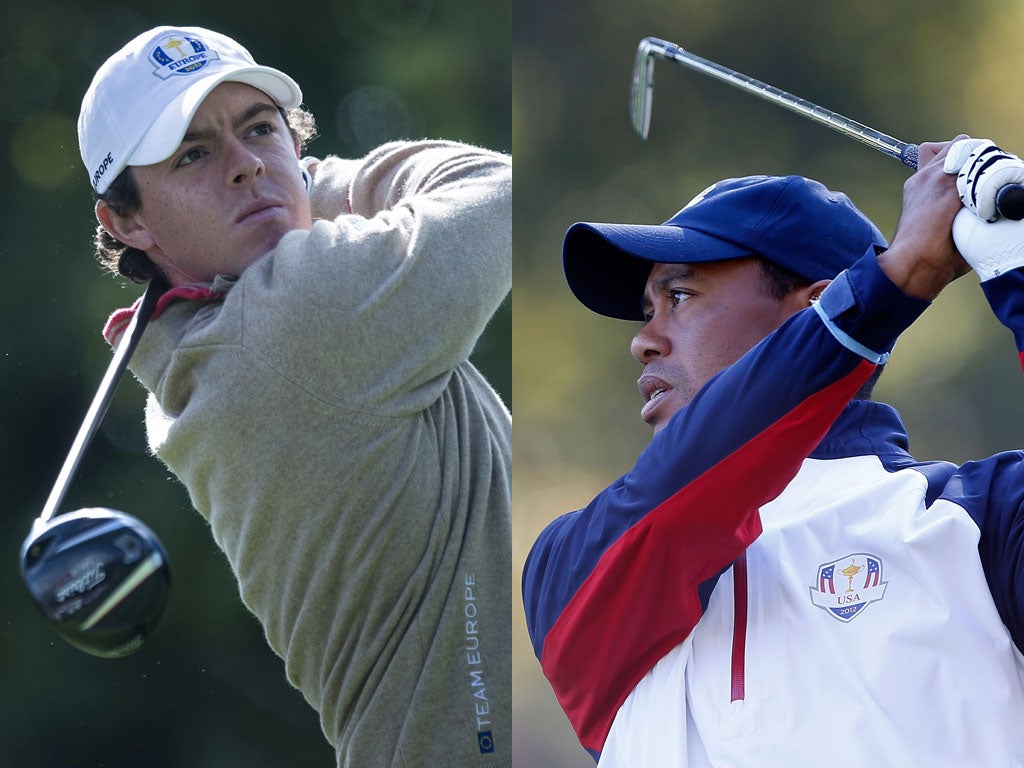James Lawton: Tiger v Rory could be the biggest duel the Ryder Cup has ever witnessed

This is not one of the world's greatest golf courses – certainly not Augusta National or Pebble Beach or St Andrews – but it is long, has been set up for a blaze of birdies to excite the American crowd to a high level of patriotism and here in the Fall it is hard to imagine a more beautiful piece of sporting landscape.
At the dawn of the 39th Ryder Cup, flights of Canada geese head south in fly-pasts imperious enough to challenge the ceremonial resources of the United States Air Force.
The foliage, on cue, is an artist's palette of russet and gold, fading green and yellow framed by a huge sky of steel blue.
The autumn air is as uplifting as a glass of the finest champagne.
It also helps that this is the scene for potentially one of the greatest collisions in the history of sport.
Yes, any sport – something indeed which in the peculiar way of golf when it brings so many of its great players together every two years, and so drastically changes its form, can compete in drama and intrigue with anything you care to mention.
Ali-Frazier was more elemental, no doubt, Nadal-Federer on Wimbledon's Centre Court was unforgettable and just a few weeks after Spain this summer retained their European football title with one performance at least for the ages, Usain Bolt recaptured the imagination of the world.
So what, quite, is on the menu here over the next few days?
There is, beyond question, a guarantee of superlative golf action and a relentless edge as the American captain, Davis Love III, calls for another explosion of wild gallery support which helped retard the growth of Europe's ascendency at Kiawah Island in 1991, Brookline in 1999 and Valhalla four years ago – and Jose Maria Olazabal counters by dressing his men in the blue of a Seve Ballesteros rhapsody and says that there could be no better memorial to the great man than some of their best golf.
Yet beyond all the urgings of the captains, and the possibility that the burning hot, and now fabulously rich American rookie Brandt Snedeker could further augment his glory these next few days while confirming his team's status as narrow betting favourites, there is one ultimate prospect that on Sunday would carry this Ryder Cup on to another dimension.
It is the chance that if, as expected, two days of team golf in the foursomes and the fourballs leave the issue much too close to call, both Love III and Olazabal will seek out their best chance of vital momentum at the start of the 12 singles.
What they might just do is create the most anticipated hand-to-hand duel in the history of the contest conceived 85 years ago by old Sam Ryder, the St Albans corn merchant who wanted to sow a new spirit in his favourite game.
The captains might write down the names Tiger Woods and Rory McIlroy at the head of their lists, put them into envelopes and then, who knows, slip them into the letter box of sporting legend.
The collision would give McIlroy yet another chance to show that in his youthful inventions, his freedom of spirit, he has indeed surpassed the Tiger more significantly than merely in the rankings of the world game. In a most extraordinary set-piece of vying ambition, and perhaps sharply contrasting levels of self-belief, the 23-year-old from Holywood, Ulster, would have the chance to mark his move to America in the most spectacular fashion.
If it was a fight, it would choke the traffic around Madison Square Garden. If it was cricket, it would fill every tier of Eden Gardens in Calcutta. If it was football, there would be standing room only in the Nou Camp or San Siro.
That it might happen, by design or just plain old serendipity, is the most alluring promise of this Ryder Cup but then if it disappears in the autumnal mist of tomorrow evening's singles' announcement we will hardly be bereft of a superb competitive edge. The pressure on even the most brilliantly gifted players will rise sharply, and if history is any guide, maybe uncontrollably. A veteran virtuoso like Phil Mickelson will be hard pressed to improve one of the tournament's most underwhelming records: played 34, won 11, lost 17, halved 2.
Luke Donald, who unlike the American, still labours to make his breakthrough in the majors, has the much superior figures of eight wins, two losses and one halved but this week he was recounting vividly the anxieties that invaded him at Oakland Hills, Detroit, eight years ago. "Everything changed," he recalls, "when I walked to the first tee."
Reasons to believe that, with or without Woods versus McIlroy, the geese are for a day or two at least heading in the wrong direction.
Join our commenting forum
Join thought-provoking conversations, follow other Independent readers and see their replies
Comments